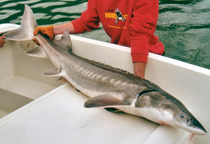Columbia sturgeon
It is the largest freshwater fish in North America and is the third largest species of sturgeon, after the Beluga and the Kaluga.

The Columbia sturgeon lives in the demersal, anadromous, freshwater, brackish, marine, depth range 1 - 122 m environment.
Columbia Sturgeon - Huge Fish That Can Live Up to 104 Years
 The Columbia sturgeon (Acipenser transmontanus) is known by many other common names, including the white sturgeon, the Oregon sturgeon and the Pacific sturgeon. But no matter what you call it, this is the largest freshwater fish in America, although it can also survive in brackish (slightly salty) and salt water, depending on its age. It is also very long-lived. The oldest known specimen lived to be 104 years old. But most Columbia sturgeons are harvested long before they reach that age.
The Columbia sturgeon (Acipenser transmontanus) is known by many other common names, including the white sturgeon, the Oregon sturgeon and the Pacific sturgeon. But no matter what you call it, this is the largest freshwater fish in America, although it can also survive in brackish (slightly salty) and salt water, depending on its age. It is also very long-lived. The oldest known specimen lived to be 104 years old. But most Columbia sturgeons are harvested long before they reach that age.
The Columbia sturgeon’s native habitats are fresh and brackish water bodies in the United States along the Pacific states of Alaska down to mid-California. The fish has been released into other lakes, streams and rivers in Idaho, Georgia and the Colorado River. Efforts have been made by game wardens and sport fisherman to remove all Columbia sturgeon from Georgia as they were accidentally introduced there and could have greatly upset the natural ecosystem. The species is not endangered.
General Description
The white sturgeon has a silhouette resembling a narrow submarine torpedo. Juveniles are miniature versions of adults. The adults grow up to 1700 pounds (816 kg) and a nose-to tail length of 20 feet (6.1 meters). Unlike many other species of fish, Columbia sturgeon has skin instead of scales. Down their back and sides from head to tail is a lone of firm pyramid-shaped pale growths. The tail is long and forked, with the top fork longer than the bottom. Their long heads include a horn-like snout and four catfish-like “whiskers” called barbels. When the fish swims head-on towards a viewer, they resemble thin alligators.
Both adult and juvenile Columbia Sturgeons over one month old are colored an alligator green with grey fins and a pale belly. The barbells tend to be white. Although called a “bony fish” by biologists and taxonomists, they do not possess skeletons of bones but of a tough cartilage. This makes them flexible and strong in the water.
Life Cycle and Behavior
Adults spawn in freshwater. Females can release about 100,000 eggs. Newly hatched fry look like tadpoles. They are born with a yolk sac which depletes in 20 to 30 days. The fry is then large enough to eat small mollusks, shellfish and insects. Once they reach 19.01 inches (48.3 cm) long, they begin hunting fish. Normally, juveniles travel upriver out to sea and stay near the coastlines. They stay in salt water until they mature. However, some populations have adjusted to being landlocked after dams were built on their waterways out to the see. They stop feeding just before spawning and go as far inland as possible. The parents take no part in raising the fry.
Juvenile sturgeons (as shown in the picture) are prey to carnivorous fish larger than themselves, including the prickly sculpin fish (Cottus asper) and the common carp (Cyprinus carpio). Adult Columbia sturgeon are fished for sport, for their meat and for their eggs, sold as caviar. Columbia sturgeons are related to the endangered Beluga and the keluga, which provide the world’s finest caviar.
Common names
Amerikanischer Stör in German (Deutsch)
Columbia sturgeon in English
Esturgeon blanc in French (français)
Esturión blanco in Spanish (español)
Esturjão-branco in Portuguese (Português)
Hvid stør in Danish (dansk)
Jeseter bílý in Czech (česky)
Jesiotr amerykanski in Polish (polski)
K'toyethen in Salish
Oregon sturgeon in English
Pacific steur in Dutch (Nederlands)
Pacific sturgeon in English
Pacifische steur in Dutch (Nederlands)
Sacramento sturgeon in English
Sacramentostör in German (Deutsch)
Stör in German (Deutsch)
Storione bianco in Italian (Italiano)
Valkosampi in Finnish (suomen kieli)
Valkosilmäkuha in Finnish (suomen kieli)
Vit stör in Swedish (Svenska)
weißer Stör in German (Deutsch)
white sturgeon in English
חדקן לבן in Hebrew (עברית)
高首鱘 in Mandarin Chinese
高首鲟 in Mandarin Chinese


Original source: FishBase
Permission: Some rights reserved
Family : Acipenseridae
Genus : Acipenser
Species : Acipenser transmontanus
Authority : Richardson, 1836
